It's a gray morning.

And thanks to this gray morning, I have experienced a wonderful aha moment --
For my non-English speaking friends, an aha moment is an instant at which the solution to a problem becomes clear.
And it's a discovery so useful that I just have to share.
A discovery resulting from the collision of two worlds -- stitching and photography.
Currently, I am in the midst of taking a photography course on Shooting in Low Light from my all-time favorite photography mentor, Karen Russell. I love how Karen's photography tells a story...how she shoots in real-life situations...how's she's got a very very busy life but still manages to take beautiful photographs.
One of the toughest situations for a photographer is taking great photographs in low light (without a flash)...and yet, we're in low light all the time. Let's face it, we're probably in low light more often than we're in perfect natural light conditions...and taking great pictures in low light settings requires a greater knowledge of all the variables that influence the photograph.
Likewise, having or, should I say not having, great light also influences the quality of our stitching. Throw in poor eyesight and adequate light becomes even more important.
From experience, I have discovered the best light for embroidery comes from southern facing windows...it's why my dining room is no longer a dining room and has become my primary place to stitch in my home.
Currently, I am in the midst of taking a photography course on Shooting in Low Light from my all-time favorite photography mentor, Karen Russell. I love how Karen's photography tells a story...how she shoots in real-life situations...how's she's got a very very busy life but still manages to take beautiful photographs.
One of the toughest situations for a photographer is taking great photographs in low light (without a flash)...and yet, we're in low light all the time. Let's face it, we're probably in low light more often than we're in perfect natural light conditions...and taking great pictures in low light settings requires a greater knowledge of all the variables that influence the photograph.
Likewise, having or, should I say not having, great light also influences the quality of our stitching. Throw in poor eyesight and adequate light becomes even more important.
From experience, I have discovered the best light for embroidery comes from southern facing windows...it's why my dining room is no longer a dining room and has become my primary place to stitch in my home.
I have also learned that the best time of day for light in this room is the first few hours of daylight. That's magic stitching time for me. It's why my blog posts are always later in the day. Stitch first, post later.
Why?
Why?
Not only is the light great at that time of day, it's also because the angle of light at that time of day gives the added benefit of sidelights.
Sidelights are lights that come from the side, illuminating three-dimensional stitching and helping to eliminate stitch shadows.
If you've ever tried to couch wires for stumpwork, couch gold thread in goldwork, stitch fuzzy technique in Japanese embroidery or do any type of small embroidery work...sidelights are critical.
When natural light is unavailable (it's night or we have a rainy, gray day), we are forced to use artificial light. There are many wonderful stitching lights out on the market and it's important to have one that mimics daylight.


Can you see the bit of shadow under the wire?


Though it may be tough to see the difference in my photographs, I took the liberty of doing a color sample in Photoshop of the exact same area under the wire in both pics. Here's the color difference.

I am convinced that sidelights work.
If you've ever tried to couch wires for stumpwork, couch gold thread in goldwork, stitch fuzzy technique in Japanese embroidery or do any type of small embroidery work...sidelights are critical.
When natural light is unavailable (it's night or we have a rainy, gray day), we are forced to use artificial light. There are many wonderful stitching lights out on the market and it's important to have one that mimics daylight.
That being said, more often than not those lights are overhead lights ergo they cause shadows on our work. Lights with a flexible arm are handy since you can manipulate the position of the light to help reduce shadow. I also use two lights to help accomplish this as well.

So, here I am stitching with my two lights on a gray day and listening to my photography class when I hear Karen say that the harshest light for indoor photography is overhead lighting; it creates shadows under the brows, nose and chin. Better to turn on all your lamps instead...this reduces those overhead shadows.
Eureka. Same goes for our needlework.
I did a little test since it was gray this morning...Using my macro lens and controlling for as many factors as possible, I took this picture of what my stumpwork petals look like with just my overhead Ott-lites...
I did a little test since it was gray this morning...Using my macro lens and controlling for as many factors as possible, I took this picture of what my stumpwork petals look like with just my overhead Ott-lites...


That shadow can prevent me from placing my needle in the right spot so that my stitches lay evenly side by side.
When couching wire in stumpwork, you learn pretty quickly that a nice clean edge is really important when you finally cut out the petals from the ground fabric. It keeps you from having a "fuzzy" edge or from cutting a misplaced couching thread by accident...though trust me, that still happens!
In the next picture, I used a big white sheet of foam board as a side "reflector" to try to eliminate some of that overhead shadow I was getting on the underside of the wire.
In the next picture, I used a big white sheet of foam board as a side "reflector" to try to eliminate some of that overhead shadow I was getting on the underside of the wire.


I am convinced that sidelights work.
So...beyond having a great stitching light, what else can we do to improve the light for stitching and to create more sidelights??
Well, I am in no way a lighting expert, but I have spent many hours at my stitching frame in all types of lighting situations and here's what I know at this point on my journey...
Well, I am in no way a lighting expert, but I have spent many hours at my stitching frame in all types of lighting situations and here's what I know at this point on my journey...
Tips for Improving the Quality of Light when Stitching Inside, in Low Light, or on a Gray Day
- Purchase a great light with magnification. (Trish Burr has a recent post on her blog which you can read here.)
- Consider working with two stitching lamps so you can increase the overall illumination of your work.
- Stitch near a window with southern exposure.
- Open any window shades or doors to increase the amount of outside light into your stitching room.
- Turn on any other ancillary lamps and overhead lights to increase the overall light in your room.
- Wear a white shirt. The color white reflects light significantly more than dark colors. Signficantly. Sounds silly, but it works.
- Work in a room with white or light colored walls. Again, white is reflective so working in a room with white or light-colored walls will improve the amount of light on your work dramatically over working in a darkly-painted or darkly-paneled room.
- Consider setting up a few white boards or mirrors on either side of your frame to increase the potential for greater sidelights.
- Addendum from Kathy: Plan to put really light window coverings in your stitching rooms. If it's a really gray day, consider closing all the drapes if you have white or light colored curtains or drapes. The reflected light from them may be brighter than the light coming in through the windows. This is also important when stitching at night.
- Purchase white lampshades instead of colored ones.
That's all I've got for today. I hope these tips help you see your work a little better.
Myself, I had never thought about wearing white, working in a room with light colored walls or using mirrors to reflect light...until I started my course with Karen.
I have made some changes myself and have noticed a big difference. Especially on a gray day.
May the light be with you...




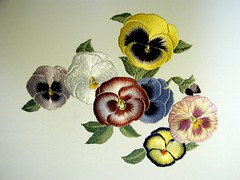
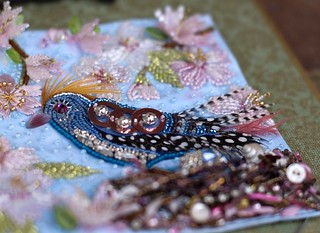
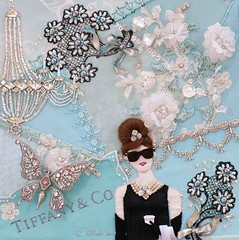
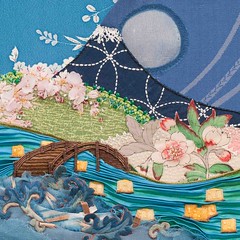
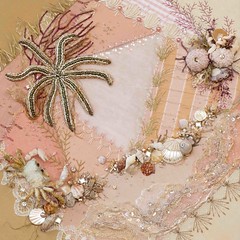


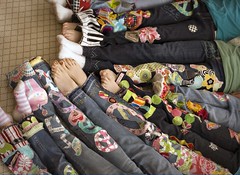









18 comments:
That's a great list of tips as we go into winter and the light becomes still lower. I'd certainly not thought of light-coloured tops, but now you mention it, it makes great sense - thanks!
Thanks a lot for all the tips you give!!! Surely it will be a great help for my tired eyes :)))
What a great post! And very timely as my house has been quite dim these days.
Thank you for the great tips! I will be using them this winter as the light is do gray and dreary.....
Here's a modification of your tips that I picked up when reading one of those "design your sewing room" books: If it's a really gray day, consider closing all the drapes if you have white or light colored curtains or drapes. The reflected light from them may be brighter than the light coming in through the windows. This is also important when stitching at night, so plan to put really light window coverings in your stitching rooms.
Hmmmm... must adjust lighting arrangements stat! I do most of my stitching sitting in my recliner with an overhead Ott-Lite but have been considering setting up an actual area that is better suited and these ideas will come in handy. Thankee, Ms. Susan. ;0)
Magnifique travail ! Bisous et bonne soirée
What a wonderful post!
Thankyou :-)
I have had some success photographing pieces with lots of goldwork outside, morning (ie slanting light coming in) on a reasonably cloudy day. It's the glitter factor thing. Someone told me that, but unfortunately I forget who.
But where's a cloudy day when you want one, sometimes? :-)
Great ideas! Thanks for sharing them.
These are fabulous tips for lighting and ease of proper seeing. Thank you so much for sharing. I had never really thought of all this very important information. Maybe my "eyesight" will improve greatly...
What an interesting post, Susan, and very pertinent to those of us living in the PNW as we enter the shortening days of the year. I had a tough time getting on your blog today or would have posted sooner. Did you get the snow over the weekend? I was thinking about your at any rate. How's that flutterby coming? Sure looked done to me, but then you mentioned tummy troubles...it's not yours.
Fabulous suggestions!! I always go tot he southern exposures to work- comes from trying to get close work done in long New England winters with tiny Historically correct windows BLAH!!!!!
I finally went to the eye Dr last week and found that I have had some significant changes in my left eye- something about my basement cells crinkling in my left cornea- Dr not too concerned but scared the !@#**@ out of me!!!! No more ceiling fans! DID you know that if you sleep with a ceiling fan going , it will dry out your cornea's - your eyes are slightly open!! WHO KNEW!!!! You are so generous with your time to create such a thorough and fabulous post!!!! Your photographs are the best!! Now I am off to check out Karen's Blog and photography class!!! Stitch on!!
Susan,
This is very helpful. Low light is troublesome...especially as I get older.
I've been pondering quite a bit about lighting recently, especially since my vision is "aging". Was also playing around with improving my photography on the blog, hence took some photos with a home made light box. I visited Karen's sight over the weekend and found loads of helpful info. Thanks again for the post. Always am amazed at your beautiful photography.
There were things you mentioned I had never considered. Since I stitch in the early morning usually in my pj's, I guess I will have to go out and buy all white ones! Really, there was a lot of great info here. I have a young photographer friend and she always speaks of the "golden hour" when there is the best light.
Thanks
Deb
Glad you discovered the white board technique. I use it all the time.
My photography muse is my guy: Pat Ryan, owner of Business Visuals.
Here is his website: www.businessvisuals.net
This is bizarre. I was just thinking about this yesterday as I was stitching. I was thinking, what do they do in photography studios to reflect light and bounce it around. So I thought about setting up a sheet of white posterboard beside me on the desk to reflect the light. I also JUST started adding in one of my older ott lights to my aresenal. I have one of the new LED/magnifier lights but the additional ott light helped even more. I will have to try wearing a white shirt and set up that posterboard. This was great!!!
Very helpful post. Thank you!
Post a Comment